
Cepora nerissa, the common gull, is a small to medium-sized butterfly of the family Pieridae, that is, the yellows and whites, which is native to Sri Lanka, India, China, southeast Asia, and Indonesia.

Pseudocoladenia dan, the fulvous pied flat, is an Indomalayan butterfly belonging to the family Hesperiidae found in India to southeast Asia.

Parnassius jacquemontii, the keeled Apollo, is a high altitude butterfly which is found in India and Pakistan. It is a member of the snow Apollo genus (Parnassius) of the swallowtail family (Papilionidae). It is also fairly common at high altitudes from Chitral to Kumaon.

Cethosia cyane, the leopard lacewing, is a species of heliconiine butterfly found from India to southern China, and Indochina. Its range has expanded in the last few decades, and its arrival in the southern part of the Malay Peninsula, including Singapore, is relatively recent.
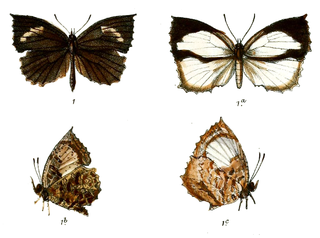
Allotinus drumila, the crenulate darkie, is a small butterfly found in India, Burma, Thailand, Laos, Vietnam, and Yunnan (China) that belongs to the lycaenids or blues family.

Pseudozizeeria maha, the pale grass blue, is a small butterfly found in South Asia that belongs to the lycaenids or blues family. The species was first described by Vincenz Kollar in 1844.
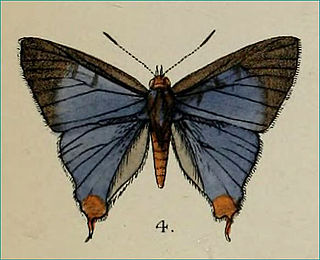
Cigaritis abnormis, the abnormal silverline, is a species of lycaenid or blue butterfly found in south India and Pakistan.

Vagrans is monotypic genus with the species vagrant a species of nymphalid butterfly found in forested areas of tropical South Asia and Southeast Asia.

Caeneressa is a genus of moths in the family Erebidae.

Thinopteryx is a genus of moths in the family Geometridae erected by Arthur Gardiner Butler in 1883.
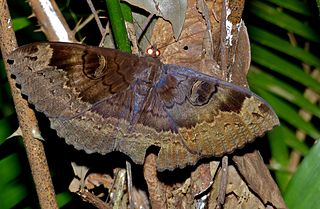
Erebus caprimulgus is a moth of the family Erebidae. It is found from the Oriental Region of India, Sri Lanka, Myanmar to Peninsular Malaysia, Sumatra and Borneo.

Aglais caschmirensis, the Indian tortoiseshell, is a species of nymphalid butterfly found in the northern regions of the Indian subcontinent, primarily in the Himalayas.
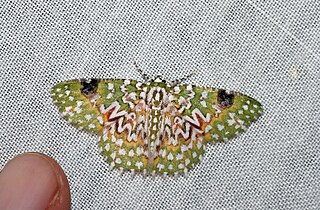
Eucyclodes gavissima, the Oriental orange banded green geometer moth, is a species of moth of the family Geometridae described by Francis Walker in 1861. It is found in the Indian subregion, Sri Lanka, Bhutan, western China, Taiwan, Sumatra and Borneo.

Apona caschmirensis is a moth of the family Eupterotidae first described by Vincenz Kollar in 1844. It is found in Nepal, Pakistan and India.
Ancylolomia chrysographellus, the angled grass moth, is a species of moth in the family Crambidae. It is found on Cyprus and in Kenya, Uganda, Yemen, India, Pakistan, Sri Lanka, Myanmar, China, Korea, Japan, Taiwan, the Philippines and Indonesia.

Calesia dasyptera is a moth of the family Noctuidae first described by Vincenz Kollar in 1844. It is found in Asia, including Taiwan, India and Sri Lanka.

Plusiodonta coelonota, the snake vine moth, is a moth of the family Erebidae. The species was first described by Vincenz Kollar in 1844. It is found from India, Sri Lanka, Myanmar, Andaman Islands, Australia, Papua New Guinea, to South and South-East Asia.

Spilosoma erythrozona is a moth in the family Erebidae. It was described by Vincenz Kollar in 1844. It is found in China, eastern Afghanistan and Himalayas.
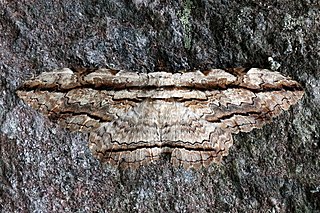
Thysania zenobia, the owl moth, is a species of moth in the family Erebidae. The species was first described by Pieter Cramer in 1776, and is native to North and South America and the Caribbean.
Caeneressa tienmushana is a species of moth in the family Erebidae. It was described by Obraztsov in 1957. It is found in China.



















